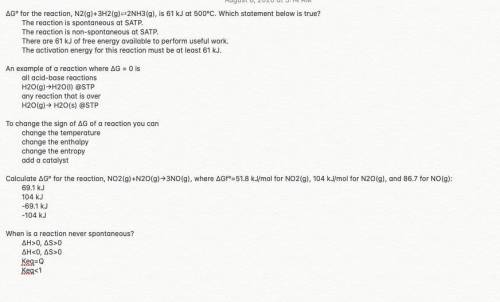
Chemistry, 12.08.2020 07:01, Jackpumpkin
To change the sign of ∆G of a reaction you can change the temperature change the enthalpy change the entropy add a catalyst Calculate ∆Gº for the reaction, NO2(g)+N2O(g)→3NO(g), where ∆Gfº=51.8 kJ/mol for NO2(g), 104 kJ/mol for N2O(g), and 86.7 for NO(g): 69.1 kJ 104 kJ -69.1 kJ -104 kJ When is a reaction never spontaneous? ∆H>0, ∆S>0 ∆H 0 Keq=Q Keq<1


Answers: 3
Other questions on the subject: Chemistry


Chemistry, 23.06.2019 01:30, bgarrison364
What is produced from neutralization of an acid and a base? a. hydronium ions b. citric acid c. salt and water
Answers: 1

Chemistry, 23.06.2019 06:30, tdahna0403
The molar mass of cu is 63.55 g/mol. the number of grams of cu produced in this reaction is
Answers: 3

Chemistry, 23.06.2019 08:00, sassy11111515
Match the vocabulary terms to their definitions. 1 . a long, chain-like set of molecules made up of repeating units joined end to end polymer 2 . a hard, brittle, heat- and corrosion-resistant material made by subjecting a nonmetallic mineral mixture to intense heat ceramic 3 . a plastic with low elongations that cannot be recycled thermoset 4 . a carbon fiber embedded in a polymer resin matrix thermoplastic 5 . a plastic with high elongations that can be recycled crystal 6 . a solid form resulting from the arrangement of atoms, ions, or molecules in definite geometric patterns composite
Answers: 1
Do you know the correct answer?
To change the sign of ∆G of a reaction you can change the temperature change the enthalpy change the...
Questions in other subjects:















